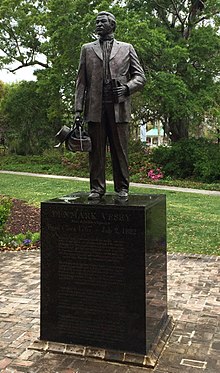Denmark Vesey | |
|---|---|
 | |
| Born | 1767 |
| Died | July 2, 1822 (aged 54–55) |
| Nationality | Virgin Islander, possibly of Coromantee or Mandé ancestry |
| Other names | Telemaque |
| Occupation(s) | Interpreter, domestic servant, carpenter, and pastor |
| Known for | Convicted of plotting a slave revolt |
Denmark Vesey (also Telemaque) (c. 1767–July 2, 1822) was a free Black man and community leader in Charleston, South Carolina, who was accused and convicted of planning a major slave revolt in 1822.[1] Although the alleged plot was discovered before it could be realized, its potential scale stoked the fears of the antebellum planter class that led to increased restrictions on both enslaved and free African Americans.
Likely born into slavery in St. Thomas, Vesey was enslaved by Captain Joseph Vesey in Bermuda for some time before being brought to Charleston.[2][3] There, Vesey won a lottery and purchased his freedom around the age of 32. He had a good business and a family but was unable to buy his first wife, Beck, and their children out of slavery. Vesey worked as a carpenter and became active in the Second Presbyterian Church. In 1818, he helped found an independent African Methodist Episcopal (AME) congregation in the city, today known as Mother Emanuel. The congregation began with the support of white clergy and, with over 1,848 members, rapidly became the second-largest AME congregation in the nation.
His insurrection, which was to take place on Bastille Day, 14 July 1822, became known to thousands of blacks throughout Charleston, South Carolina, and along the Carolina coast. The plot called for Vesey and his group of enslaved people and free blacks to execute their enslavers and temporarily liberate the city of Charleston. Vesey and his followers planned to sail to Haiti to escape retaliation. Two enslaved men opposed to Vesey's scheme leaked the plot. Charleston authorities charged 131 men with conspiracy. In total, 67 men were convicted and 35 hanged, including Denmark Vesey.[4][5] Historian Douglas Egerton suggested that Vesey could be of Coromantee (an Akan-speaking people) origin, based on remembrance by a free black carpenter who knew Vesey toward the end of his life.[6]
- ^ Cite error: The named reference
spadywas invoked but never defined (see the help page). - ^ "Connections to Charleston, South Carolina, by Dr Edward Harris. The Royal Gazette, City of Hamilton, Pembroke, Bermuda. Published 16 November, 2013". November 16, 2013.
- ^ Egerton 2004, pp. 1–4.
- ^ "Denmark Vesey Archived 1 December 2008 at the Wayback Machine", Knob Knowledge, Daniel Library, The Citadel, The Military College of South Carolina.
- ^ "About The Citadel Archived 20 September 2006 at the Wayback Machine", Office of Public Affairs, The Citadel, The Military College of South Carolina, May 2001.
- ^ Egerton (2004), pp. 3–4.